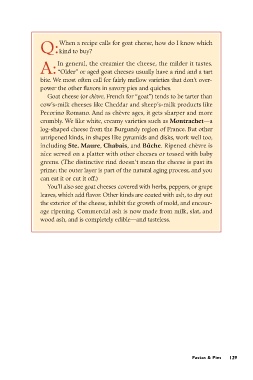Page 129 - One-Dish Meals
P. 129
When a recipe calls for goat cheese, how do I know which
Q:kind to buy?
In general, the creamier the cheese, the milder it tastes.
A:“Older” or aged goat cheeses usually have a rind and a tart
bite. We most often call for fairly mellow varieties that don’t over-
power the other flavors in savory pies and quiches.
Goat cheese (or chèvre, French for “goat”) tends to be tarter than
cow’s-milk cheeses like Cheddar and sheep’s-milk products like
Pecorino Romano. And as chèvre ages, it gets sharper and more
crumbly. We like white, creamy varieties such as Montrachet—a
log-shaped cheese from the Burgundy region of France. But other
unripened kinds, in shapes like pyramids and disks, work well too,
including Ste. Maure, Chabais, and Bûche. Ripened chèvre is
nice served on a platter with other cheeses or tossed with baby
greens. (The distinctive rind doesn’t mean the cheese is past its
prime; the outer layer is part of the natural aging process, and you
can eat it or cut it off.)
You’ll also see goat cheeses covered with herbs, peppers, or grape
leaves, which add flavor. Other kinds are coated with ash, to dry out
the exterior of the cheese, inhibit the growth of mold, and encour-
age ripening. Commercial ash is now made from milk, slat, and
wood ash, and is completely edible—and tasteless.
Pastas & Pies 129

